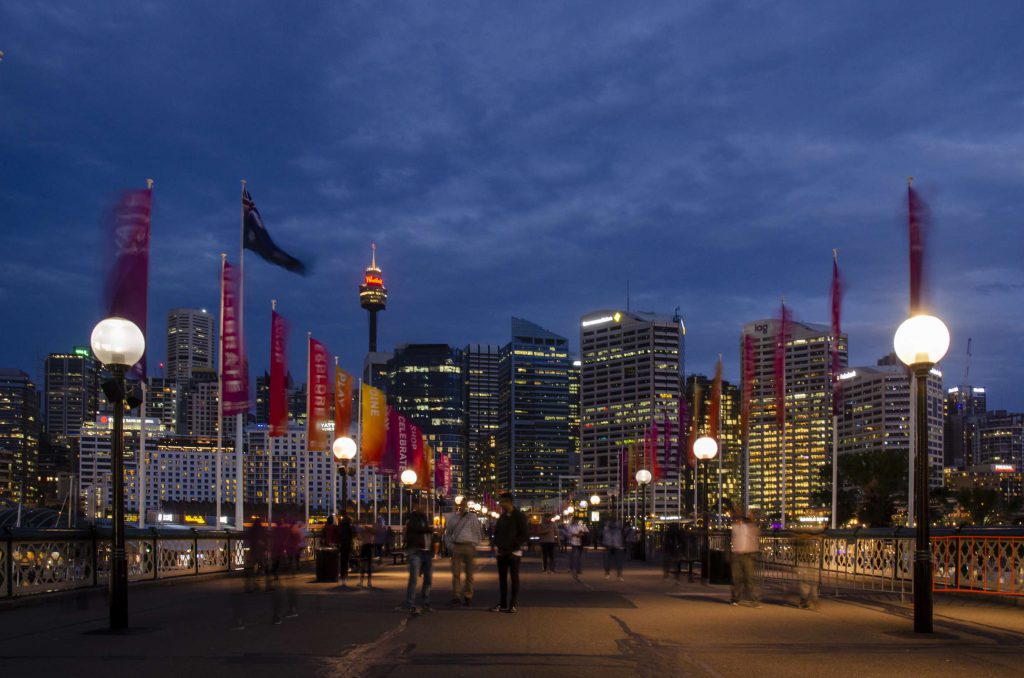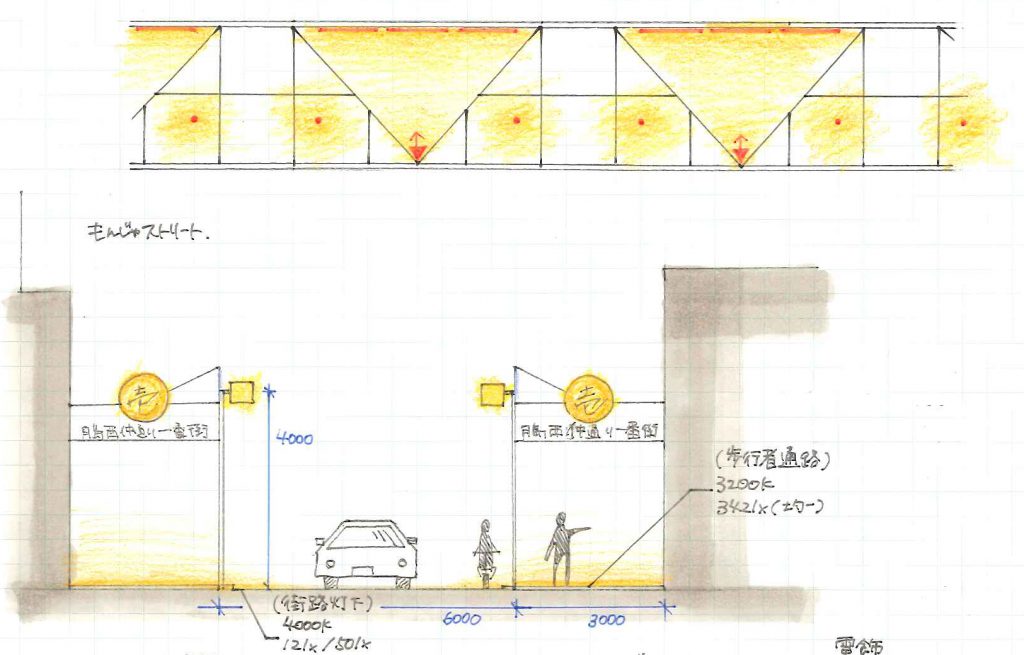発行日:2020年2月3日
・照明探偵団倶楽部活動1/Sydney Lighting Survey(2019.09.19 – 2019.09.21)
・照明探偵団倶楽部活動2/東京調査 佃・月島(2019.11.18)
Sydney Lighting Survey: How Sydney CBD glows at night
2019.09.19 – 2019.09.21 Momoko Muraoka + Sunyoung Hwang
Sydney, a capital city of New South Wales is famous for its beautiful beaches and iconic Opera House.
It makes it to the most populous city of Australia with more than 5.2million population. The climate of Sydney is subtropical with no extreme seasonal differences.

Highly saturated clear blue sky, lush greeneries, beautiful waterscape, and iconic Opera House – Sydney is the city that has it all. It is quite a lovely place to be and usually makes it to the top rankings for the most liveable cities in the world.
This time, Lighting Detectives flew to Sydney to find out how it lights up at night as a famous tourist destination. The survey focuses on the Sydney CBD (Central Business District) area. When looked down from the Sydney Observatory, the city did not have much of the façade lighting. Many of the buildings were glowing with their interior lights. There were not much of RGB lights nor media facade light except few areas of Darling Harbour and Pitt Street, the shopping district.



The shot taken from North Sydney to have an overall view of Sydney CBD with iconic Opera House and Harbour Bridge shows this more clearly. Sydney seemed rather classic with a warm tone of lighting on these iconic features and minimum architectural lights.

Interview with the city of Sydney

Interview with Laurence Johnson from City of Sydney
On the first day of arrival, we have met up with Laurence from Public Domain Strategy department from the City of Sydney to ask about Sydney lighting design direction and vision. Starting in 2000, Sydney has a lighting code that controls the night-time illumination of the buildings. Although Sydney does not have a masterplan that overlooks the Sydney CBD in general, important districts of CBD area has its lighting masterplan, and the city of Sydney is developing and updating more of those. The city is also looking into having more of the façade lighting to CBD area to activate the nightlife more than what it is now. This facade light-up works go along with the Open Sydney 2030, which is a strategy for the development of Sydney’s night-time economy. The city is looking for a balance between planning to boost the night-time economy and being sustainable and conscious of energy consumption. One of the most interesting parts we learned from the interview is that the city puts safety as a priority when it comes to the lighting of the city. It sounded that the city has a stringent requirement for light levels in public areas.

George Street, Sydney in 1950

George Street, Sydney in 2019 (at Night)

Queen Victoria Building in George Street, Sydney in 2019

George Street, Sydney in 2019
Sydney CBD roads
From the late 1800s to the 1960s, Sydney had the extensive tram system running along the main roads of Sydney. The trams then faded out in favour of buses from the 1960s to 2015 until Sydney decided to bring back the old tram system back to make more pedestrian-friendly roads. This massive change in the mode of transportation affected the lighting design of CBD roads as well. Following the direction from ‘Sydney Design Code” which was issued in 2015 by the City of Sydney, the design of pole light on the road where light rail runs have changed to accommodate the structural and operational requirements for the light rails such as signage, signalling and overhead wires. The customised light pole design also helps to identify where the light rail is running. During our survey, CBD light rail system was partially operating, and we were able to spot the new pole lights with multiple tiers of light source were installed. The light levels of George street were quite bright at an average of 100lux and mostly cool white (4000K) were used.

Opera House, Sydney

Darling Harbour, Sydney

Entrance of Queen Victoria Building, Sydney
Street lighting design module
In contrast to the lighting design scheme of George Street where the choice of streetlight accentuates modern look of the city, there are many other areas in the city where a rather decorative and historical lighting design module is used. For example, throughout Darling Harbour and Clarke Quay, similar sphere shape pole lights were spotted and in Queen Victoria Building, spherical pendant were used for interior space. Having a similar design language for different parts of the city adds to the sense of continuity in city scale and it was noteworthy to see the continuation of design language between exterior and interior space. We thought that these types of lighting designs come in human scale and add a rhythm to the city nightscape.
Sydney Central Station

Highliy illuminated at Station square

Sydney central staion facade

Grand concourse with blue ambient light

Platform illuminated evenly at 320 lux average.
More than 100 years old station building stands with a dignifying presence while functioning as a core hub of transportation in Sydney. As for its night-time scenery, lighting seems to focus more on providing functional needs. We had found that walkways are evenly lit with a high range of brightness for the general public. Station Square and the approach pathway to the building are illuminated intensively at around 300 lux average. The Grand concourse is lit with blue colour ambient lighting, which again gives a uniform and even illumination to the floor. From the personal and professional point of view, we thought that the architectural features of the heritage station could have been highlighted better, creating a more dramatic and beautiful space. Although it was understandable that crime prevention is a crucial consideration when it comes to lighting design for a station, we could not help but ponder why the platform was having higher lux levels than some of the libraries we visited in Sydney.
Darling Harbour and Streets

Looking at CBD from Prymont Bridge

Darling Harbour waterfront

Not much attention could be captured at the most of street level lighting condition

University of Technology Sydney has very unique buildings
Darling Harbour is one of the most vibrant and bustling areas of the city, and it was by far the most colorful and noisest area at night in the Sydney CBD. However, we noticed that many of the building facades and pedestrian walkways along the harbourside were not lit, and the interior lighting of F&B shops rather generated the night-time mood for the place.
Global Climate Strike (Sept 19, 2019)
It was such a sight to witness Global Climate Strike in Sydney, which have gathered around 50,000 people across Sydney. Organisers want the government and business to commit to a target of net-zero carbon emissions by 2030.
On a side note, under the city of Sydney’s development plan ‘Sustainable Sydney 2030, ‘the government plans to reduce greenhouse gas emissions by 70percent by 2050 compared to 1990s levels. A 10% reduction is possible by adopting more efficient lighting sources.
(Momoko Muraoka)


東京調査: 佃・月島
2019.11.18 田窪恭子+安齋雄一+渡邉 菜見子

月島の俯瞰写真。賑やかな高層ビル群の光とは対照的に、商店街や細い多数の路地からは光は漏れて来ない
江戸時代に造られた漁師の島、佃。明治時代に埋め立てられ今では多くの長屋や狭い路地が残されている月島。再開発が進む東京湾岸地域の中で、現代的高層ビルと古い町並みが隣接しているこの地域の光環境を調査した。
佃

佃1丁目メインストリート。駄菓子屋さんの店先で遊ぶ子供たち

佃1丁目メインストリートは水銀灯がベース照明となっている

佃まちかど展示館。照明光源はLED3000K,照度は134lx
調査は佃対岸の高層ビルからの俯瞰撮影から始まった。中央区の高層ビル群が乱立する光景の中で、暗闇に隠れているエリアがあった。そこが今回の調査地、佃・月島である。周りをぐるっと賑やかなビルに囲まれているため、より暗さが際立って見える。
地上に降り、まず佃1丁目(旧佃島)のメインストリートに向かってみると、水銀灯の街路灯(4500K)が緑掛かった白色の光を放ち道を照らしていた。平均照度は11lxほど。日中は駄菓子屋の店先で子供たちが遊んでいる懐かしい光景が見られるが、夜間は車も人の往来も少ないため静まりかえった通りとなっていた。唯一周囲と異なる光があるのが、道の突き当りにある佃まちかど展示館。江戸時代から続く地域の大祭、住吉神社例祭の神輿や獅子が展示されているのだが、電球色の暖かい光に包まれた空間は水銀灯の道とのコントラストからフォーカルポイントとなっていた。
辺りを散策していると江戸時代から続く神社仏閣が1丁目には点在していることが分かった。佃天台地蔵尊は民家の間の細い路地の奥、初めて訪れる者には見つけにくい場所にあるのだが、お線香の香りが微かに残る綺麗に掃除された内部は蛍光灯で明るく照らされており(133lx)、地元の方の地蔵尊への愛着が照明からも感じられた。
同じく江戸時代から佃地域を守り、多くの信仰を集めてきた住吉神社では、2700Kの光を放つ新しい石灯篭が夜の参拝者を温かく迎えていた。
幕末にできた灯台を復元した石川島灯台は夜間ライトアップされていた。この町全体は水銀灯の光が目立つが、歴史があり地元の方に愛されてきた場所は丁寧な光で照らされている印象を受ける。
佃は住宅地のため、ゆっくりと寛げる暗がりがあることは悪いことではないと思う。しかし明治以降にできた周囲の埋め立て地にはない歴史、文化を有する土地のため、冷たい水銀灯の光ではなく温かみがある色温度で、且つ佃の歴史が感じられるデザインの灯具も地元の方に寄り添っていてほしいと感じた。
(安齋雄一)

佃天台地蔵尊入り口

住吉神社
月島

西仲商店街 もんじゃストリート

もんじゃストリート断面図

もんじゃストリートアーケード
もんじゃの街月島は、明治25年に東京湾が埋め立てられ誕生した。当時工場が多く建設され、そこで働く労働者のための住宅が必要になった為、月島に多数の長屋が建てられその間を縫うように細長い路地も作られた。その後の関東大震災や東京大空襲で街並みが変わった他の東京都心部とは異なり、その影響が少なかった月島は開発が進む湾岸エリアの中で今でも明治時代からの街並みが残っている珍しい街となっている。
月島での調査はもんじゃストリートで有名な西仲商店街を軸とし、そこから延びる狭い路地と裏道も対象とした。地下鉄月島駅方面から西仲通り一番街に入り初めに目に留まったのは、一番街から四番街まで続く400mほどのアーケード。そこには蛍光灯、ダウンライト、スポットライトがリズミカルに配置され、三角に規則的にくり抜かれた天井面は白色の蛍光灯で照らされ電球色ダウンライトの丸い形と共に幾何学的な可愛らしい模様がずっと奥まで続いていた。アーケードの真下は色温度3200K、照度340lxが保たれ、温かい光があるせいか、一部歩行者天国になっている中央の広い道路ではなく、ほとんどの通行人がこのアーケードの下を選んで歩いているのが印象的だった。しかし、アーケードにはクリスマス用のイルミネーションだろうか、青と白の電飾が交互につけられ他の温かな光とは印象が異なっており、さらにコードが目立っていたのが残念であった。
一歩路地に入るとベース照明が乏しく商店街よりかなり暗い印象を受けた。しかし、飲食店がある路地には、店から漏れてくる光や賑やかな色を放つ看板が置いてあり、奥へ足を運ばせる、奥には何があるのかと好奇心をそそる光景を作っていた。路地に面したお店の客は比較的地元や常連の方が多く、観光地になっている西仲商店街とは異なる印象を受けた。路地からはみ出しもつ煮を食べながら楽しそうにお酒を組み合わしている方々の姿もあり、出店が並び労働者で賑わった月島の光景が路地裏にはまだ残っているように感じた。 (渡邉菜見子)

もんじゃストリート裏路地

路地のもつ焼き屋
まとめ
新たな高層マンションの建設が仲西通り2番街東側で進んでいる。もんじゃストリートに面するマンション低層階では長屋風の店舗計画があるようで、今後も周りの建物が変わっても観光地でもある商店街は守られていくのだと思う。だがこの地域の特徴であった、細い裏路地、長屋、そこで暮らしていた地元の方々の生活・文化は今後どうなってしまうのだろうか。
今後も確実に変わり続けていくこの街で、今まで受け継がれてきたものが残るのか、新しくなるのかは近い未来で決まってしまうのだろう。だが豊洲にも晴海にもないこの街独自の趣、特徴は時代が変わってもぜひ守られていってほしい。
(安齋雄一)



















